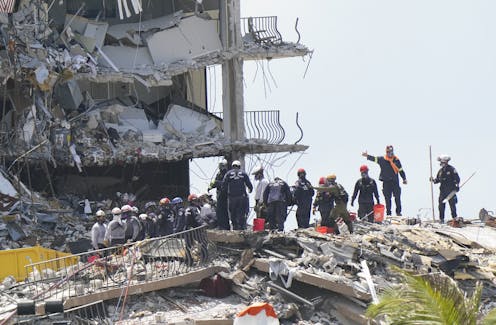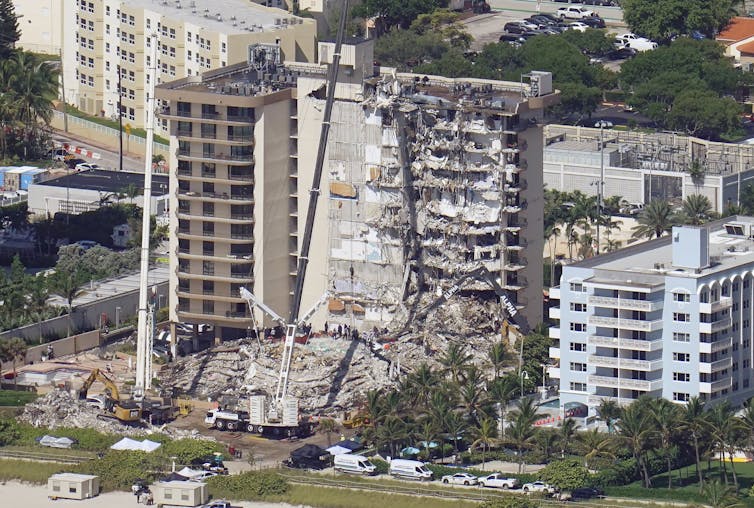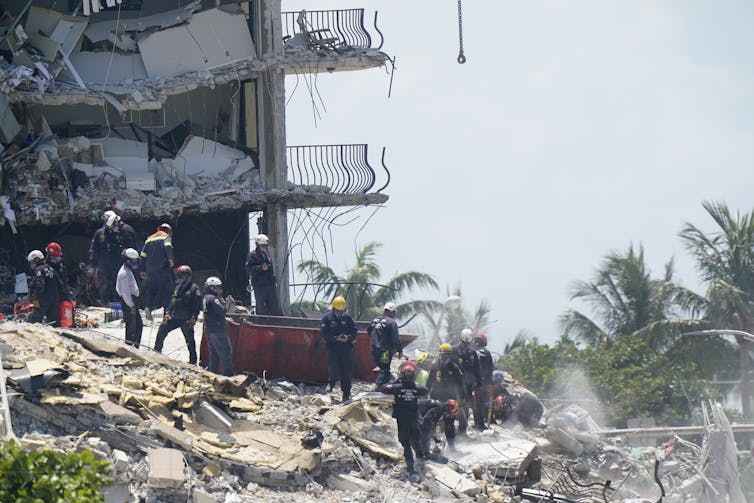Florida condo collapse – searching for answers about what went wrong in Surfside can improve buildin
Investigators are searching for what caused the tall apartment building near Miami to suddenly fail. What they find could lead to changes in building codes.

The collapse of a huge condominium building near Miami, Florida was shocking news to wake up to on the morning of June 24, 2021. It is one of the worst building collapses in recent U.S. history.
I am a professor of engineering and have been studying structural failures – and the lessons people learn from them – for about 25 years. My colleagues and I from the American Society of Civil Engineers and the American Concrete Institute will be studying this tragedy to figure out what lessons we might learn.
How does a building stand for 40 years and then collapse, perhaps with little or no warning? Why did it collapse so that part of the building stayed up, sparing many lives? It might take months or longer for engineers to find answers to these questions. But those reports, when they do come, are important because engineers can use them to improve building codes and other safety measures – and hopefully prevent future collapses.

How does a building collapse?
A collapse needs only two things – the right conditions and a trigger.
The conditions that make a building weak could be design errors, construction errors or corrosion. In this case, 40 years of corrosive ocean air may have degraded steel, concrete and other materials. Triggers can be natural events – like an earthquake or a tornado – or man-made like a bomb or collision.
So why, after standing 40 years, did the building in Florida collapse?
To look for clues about the condition of a building, engineers often start by reviewing all available records. In this case, the town of Surfside, Florida, quickly released a number of key documents for the public to access. These include the building plans from 1979 and a nine page report documenting a structural field survey carried out in 2018. It is unusual for engineers to get a field survey report because these usually aren’t done or are only provided to the owner. It will probably prove very useful in understanding the building’s condition before the collapse.
And the trigger? As I write this, no one yet knows what event caused the collapse. The key evidence is likely still buried under the rubble. Finding the trigger will be the job of forensic engineers who will come up with a series of hypotheses and then use the available evidence to eliminate the options until one trigger remains. Essentially, it’s the Sherlock Holmes method: “When you have eliminated all which is impossible, then whatever remains, however improbable, must be the truth.”

Failures improve regulation
When a building collapses, finding out what caused the failure is critical so that engineers can suggest updates to building codes, specifications and regulations and prevent future disasters.
A team of investigators from the National Institute of Standards and Technology has already traveled to the site. These engineers serve on code-writing committees and will be in an excellent position to implement what they learn.
In my book “Beyond Failure,” I discuss many examples of how collapses have led to changes in codes. The 1940 collapse of the Tacoma Narrows Bridge, for example, led to an entire new field of research into how to predict and address wind effects on flexible bridges.
In 1981, the National Institute of Standards and Technology – then known as the National Bureau of Standards – investigated the collapse of the Harbour Cay Condominium that occurred while the building was under construction in Cocoa Beach, Florida. Due to a building boom in Florida at the time, as I report in my book, there was a shortage of qualified structural engineers. As a result, the Harbour Cay Condominium was designed by two retired NASA engineers instead of engineers who specialize in building design. These two made many basic blunders in designing the reinforced concrete, particularly with regards to the concrete slabs and columns and the critical connections between them. In this case, existing codes were adequate but not followed. On Sept. 13, 1981, the Associated Press reported that the two engineers had surrendered their licenses following investigation by the Florida Department of Professional Regulation.
Usually when buildings collapse, forensic engineers are hired by lawyers on behalf of parties who might get sued – the building owner, the architect, the structural engineer, the contractor and others. Lawsuits are already underway after the recent collapse in Florida. Since these lawsuits are between private parties, the results of private investigations for the lawsuit will be confidential and thus may never come to light. But with the National Institute of Standards and Technology getting involved, I expect there will a separate public report in this case, unrelated to the private investigations. When government agencies aren’t involved, there is an established system for engineers to anonymously report problems that might cause risk to public health and safety. The system is still very new, but something similar has worked well in the U.K.
While engineers may not know for some time exactly what happened in Surfside, I expect this to be a landmark case with many important lessons. By carefully studying this tragedy, we may be able to save lives in the future.
[You’re smart and curious about the world. So are The Conversation’s authors and editors. You can read us daily by subscribing to our newsletter.]
Norb Delatte received funding from the National Science Foundation. He is affiliated with the American Society of Civil Engineers and the American Concrete Institute.
Read These Next
What’s at stake in Trump’s executive order aiming to curb state-level AI regulation
In the absence of comprehensive federal AI regulation, states have stepped in. The Trump administration,…
The Bible says little about Jesus’ childhood – but that didn’t stop medieval Christians from enjoyin
Legends about Jesus’ early years that circulated in medieval Europe often drew on apocryphal texts.
Data centers need electricity fast, but utilities need years to build power plants – who should pay?
How many data centers will be built – and how much electricity they’ll need – is uncertain. Being…





